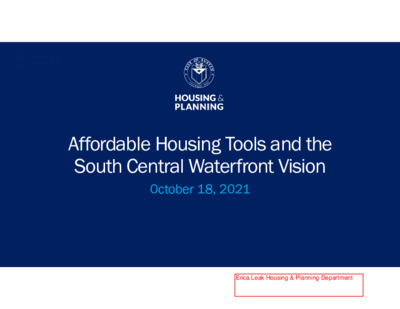Item 3.c.: Affordable Housing Tools and South Central Waterfront Vision — original pdf
Backup

Affordable Housing Tools and the South Central Waterfront Vision October 18, 2021 Content SCW Vision City of Austin Affordable Housing Goals Affordable Housing Tools & Limitations Next Steps South Central Waterfront Vision • Mobility and Connectivity • Trails and Open Space • Sustainable Design • Urban Design • Public Art • Affordable Housing • Goal of 20% Affordable Housing within the District 3 Austin Strategic Housing Blueprint • Create 20,000 Housing Units in 10 Years that are affordable to households earning 30% MFI and less • Create 25,000 Housing Units in 10 Years that are affordable to households earning 31‐60% MFI • Create 15,000 Housing Units in 10 Years that are affordable to households earning 61‐80% MFI • 25% of affordable housing units that are created should have two or more bedrooms and a system to provide opportunities for families with children • 25% of affordable housing created to be within ¼ mile of high‐ frequency transit • At least 25% of new income‐restricted affordable housing to be in moderate‐to‐high opportunity areas • Protect Renters from Discrimination Based on Source of Income • Utilize Tax Increment Financing (TIFs) for Affordable Housing • Maximize Public Property to Build or Include Affordable Housing • Expand the Supply of Housing for People with Disabilities • Develop policies to prioritize affordable housing near current and future transit service • Link housing choices with transportation choices • Comprehensive Parking Reform • Recalibrate, streamline, and expand density bonus programs to serve renters at or below 60% MFI • Incorporate Robust Tenant Protections for All Rental Properties Receiving City Support Analysis of Impediments to Fair Housing • Implement Displacement Mitigation Strategies and Housing Blueprint action items • Encourage developers and landlords who benefit from public funding and development incentives to adopt reasonable policies on tenant criminal history, accept legal unearned income in consideration of the ability to pay rent, and not discriminate based on source of income. • Bring forward the recommendation that incentives for the development of affordable housing for households below 50%, 60% and 80% MFI be included in Land Development Code revisions. • Improve connections between low‐income populations and employment opportunities. Displacement Mitigation Strategy (2018) • Preference Policy to prioritize new city‐subsidized affordable units for income‐qualified households that are appropriately sized to the unit and/or have ties to the city • Land Bank in Gentrifying Areas to Acquire and Develop Affordable Housing • Support the Creation of Deeply Affordable Units at 20% and 30% MFI and Below 4 Austin Strategic Housing Blueprint Key Strategies: • Market Key Strategies: • Regulations • Strike Fund Key Strategies: • Subsidies Key Strategies: • Subsidies • Incentives Key Strategies: • Strike Fund • Incentives 5 Austin Strategic Housing Blueprint FUNDING MECHANISMS AND TOOLS FOR 60,000 AFFORDABLE UNITS Current Tools & Funding (approx.) 6 Aligning SCW Vision with Housing Goals Use incentives to create housing affordable to households earning 60-80% MFI Use subsidies to create housing affordable to households earning less than 50% MFI Create affordable housing near transit Create affordable multi-bedroom units Create robust Tenant Protections Maximize public properties to create affordable housing Affirmatively furthering Fair Housing 7 Banned in Texas: × Linkage fees × Inclusionary zoning × Rent control (w/o Gov approval) × Source of Income protections × Real estate transfer tax × Income-based property tax adjustments × Local minimum wage increases Affordable Housing Tools Regulations – LDC: Housing form, location, density Voluntary Development Incentives Subsidies – Federal funding – Local funding and Agreements – Regulating Plan – Density Bonuses PUD – Bonds, Housing Trust Fund Alternative Financing – Low Income Housing Tax Credits – Tax Increment Financing – Site-specific negotiated development agreements that provide superior development to what could be built with conventional zoning City-Owned Land – Partnerships – Community Land Trusts 8 Leveraging Voluntary Development Incentives Evaluate Value of Bonus Entitlement Value of Bonus Entitlements Cost to Provide Public Benefit Calibrate Community Benefit Requirements or recalibrate the bonus entitlements offered 9 Leveraging Subsidies + Financing Federal Funds Local Funds – CDBG – HOME – Continuum of Care funding – Low Income Housing Tax Credits – Housing Trust Fund – General Obligation Bond – Other Local Financing Tools – (Such as Tax Increment Financing / Tax Increment Reinvestment Zones, Public Inprovement Districts (PID)) 10 Leveraging City-Owned Properties Partnerships Community Land Trusts November SCWAB mtg 11 Combining Incentives and Subsidies Affordability Unlocked Housing Development SMART Housing Assistance 12 Affordable Housing Requirements in the Regulating Plan Affordable Housing Within the District or Outside – Within the district to the extent possible – Alternatives for affordable ownership units and non-residential projects* Depth of Affordability – 60% MFI or lower for rental – 80% MFI for ownership** Legal Protections and Rights – Tenant protections 13 Interconnected • One Texas Center • Related to the overall District goals • SCW Gap Financing Need • Affordability depths • Affordable housing within the district 14 Challenges Opportunities Setting affordable housing policies in the regulating plan before our financing tools are fully understood Creating below-market rate housing in a vibrant, resourced area Affordable homeownership in market-rate downtown developments Maximizing city-owned property for affordable housing Limited scope of the “tipping parcels” vs the district-wide goals Include more properties in the regulating plan than just the “tipping parcels” Bonus entitlements were not calibrated to cover the cost of all public benefits in the vision Reevaluating entitlements to achieve community benefits 15 Next Steps Financial toolbox feasibility Statesman PUD resolution Regulating plan revisions and adoption, including incentives for affordable housing 16